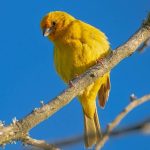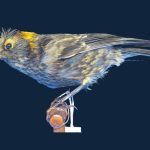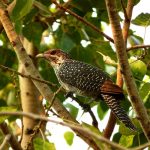Common Name: Greater ʻAmakihi
Scientific Name: (Viridonia sagittirostris)| Size | Diet | Range in Hawaii | Status in Hawaii |
|---|---|---|---|
| 4.5 in. - 5.5 in. | nectar and small insects | island of Hawai'i (Big Island | Extinct |
The Greater ʻAmakihi (Viridonia sagittirostris) was a fascinating and unique bird species that was endemic to the Island of Hawaii. With its distinctive green and yellow plumage and playful behavior, this honeycreeper was a beloved sight in its natural habitat. Sadly, the species has been declared extinct, with the last recorded sighting dating back to 1901.
In this article, we’ll explore the fascinating world of the Greater ʻAmakihi, its role in Hawaii’s ecosystem, and the circumstances that led to its extinction.
Greater ʻAmakihi
Appearance
The Greater ‘Amakihi, a now-extinct bird species found in Hawaii, had distinct physical characteristics. It was described as an oriole-like bird and was approximately 4.5 to 5.5 inches in length.
While specific details about its appearance are limited, it is believed to have displayed traits typical of honeycreepers, such as a curved bill suited for feeding on nectar and small insects. The plumage coloration and pattern of the Greater ‘Amakihi are not specified in the provided information.
Diet
The diet of the Greater ‘Amakihi primarily consisted of nectar and small insects. Similar to other honeycreepers, the Greater ‘Amakihi possessed a specialized curved bill that was well-suited for extracting nectar from flowers.
This nectar served as a crucial energy source for the bird. In addition to nectar, the Greater ‘Amakihi also fed on small insects, which provided an additional protein-rich food source. By foraging for nectar and insects, the bird played an important role in pollination and maintaining the ecological balance within its habitat.
Nesting
The nesting behavior of the Greater ‘Amakihi involved the construction of intricate nests. Female Greater ‘Amakihis were responsible for building the nests using a variety of materials including twigs, leaves, grass, and moss. These nests were typically placed in trees or shrubs, providing a secure and sheltered environment for incubating eggs and raising offspring.
The female birds displayed remarkable skill in nest construction, meticulously weaving the materials together to form a sturdy and well-insulated structure. Once the nest was complete, the female would lay her eggs and diligently incubate them until they hatched.
While specific details such as the incubation period and number of eggs are not provided, the nesting habits of the Greater ‘Amakihi demonstrate their adaptability and resourcefulness in creating a suitable habitat for successful reproduction.
Behavior
The behavior of the Greater ‘Amakihi encompassed several notable characteristics. Like many honeycreepers, the Greater ‘Amakihi displayed a nectarivorous feeding behavior, relying on the consumption of nectar from flowers as a primary energy source. Their specialized curved bills allowed them to extract nectar efficiently.
In addition to nectar, the Greater ‘Amakihi supplemented their diet with small insects, which provided essential protein. They likely foraged actively, flitting between flowers and vegetation in search of these food sources.
The Greater ‘Amakihi was also known for its territorial nature, defending its feeding and nesting areas from other individuals. Males likely engaged in territorial displays, such as singing and vigorous chasing, to assert their dominance and attract mates. The specific details of courtship and mating rituals remain unspecified in the available information.
Furthermore, the Greater ‘Amakihi was believed to be primarily a lowland species, inhabiting specific regions above Hilo in Hawaii at elevations ranging from 370 to 1,200 meters.
Habitat
The exact characteristics of its habitat are not explicitly provided, but it is likely that the Greater ‘Amakihi preferred areas with a combination of forested vegetation and flowering plants. These habitats would have provided the necessary resources for the bird’s nectarivorous feeding behavior, such as an abundant supply of nectar-producing flowers.
Range
The Greater ‘Amakihi had a limited range in Hawaii, specifically in the area above Hilo on the island of Hawai’i (Big Island). It was observed at elevations ranging from 370 to 1,200 meters. The bird inhabited a restricted region that was affected by human activities, including the clearing of land for sugar cane fields.
It was primarily found in lowland areas within this range but eventually faced extinction due to various factors, including habitat loss, avian diseases, and other human-induced changes to its environment.
Conservation Status
The Greater ‘Amakihi, a bird species native to Hawaii, is considered extinct. It met its unfortunate fate due to a combination of factors including habitat destruction from clearing land for sugar cane fields, avian diseases, and other human-induced changes to its environment.
The last confirmed sightings and collections of the Greater ‘Amakihi occurred between 1892 and 1901. Despite efforts by ornithologists to secure more specimens, the bird became increasingly rare, and subsequent searches in the following decades proved unsuccessful.
Interesting Facts
1. Discovery and initial collection
The Greater ‘Amakihi was first discovered in 1892 by ornithologist Palmer, who collected the first specimen along the Wailuku River.
2. Nectarivorous diet
The Greater ‘Amakihi primarily fed on nectar but also consumed small insects, providing a protein-rich food source.
3. Territorial behavior
The Greater ‘Amakihi exhibited territorial behavior, defending its feeding and nesting areas from other individuals of its species.
Frequently Asked Questions
1. Why did the Greater ‘Amakihi go extinct?
The extinction of the Greater ‘Amakihi can be attributed to various factors, including habitat destruction from clearing land for sugar cane fields, avian diseases, and other human-induced changes to its environment.
2. Are there any surviving relatives or similar bird species to the Greater ‘Amakihi?
While the Greater ‘Amakihi is now extinct, it is believed to be related to the extinct genus Aidemedia, known from subfossil remains found on other Hawaiian islands.
3. Are there any similar bird species in Hawaii that are at risk of extinction?
Yes, several bird species in Hawaii are currently at risk of extinction due to habitat loss, invasive species, and other factors. Examples include the Hawaiian Crow, ‘Akikiki, and ‘Akeke’e. Conservation efforts are underway to save these endangered species.




